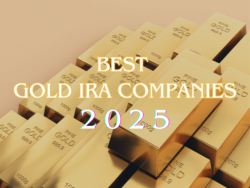Fortifying Your Future in Uncertain Times

The economic landscape of 2025 presents a complex tapestry woven with threads of persistent inflation, geopolitical tremors, and evolving central bank policies. For diligent retirement savers, navigating these currents requires more than just a basic map; it demands sophisticated strategies aimed squarely at enhancing portfolio resilience. While many investors have wisely turned to Gold Individual Retirement Accounts (IRAs) as a foundational tool—leveraging precious metals historical reputation as an inflation hedge and a diversifier against traditional market volatility—simply opening a Gold IRA is often just the first step. The true potential for safeguarding and growing retirement wealth in today’s environment lies in moving beyond the fundamentals and embracing more nuanced, advanced Gold IRA strategies.
This comprehensive guide is designed for investors seeking to elevate their approach to Gold IRA 2025 management. We will delve into sophisticated techniques that transcend basic setup and allocation, exploring how to strategically diversify within your Precious Metals holdings, incorporate informed market analysis for timing contributions and rollovers, and seamlessly integrate your Precious metal IRA into a broader, robust retirement plan. By mastering these advanced concepts, you can significantly bolster your portfolio’s ability to withstand economic shocks and position yourself for greater long-term financial security. Prepare to unlock the next level of strategic investing for enhanced portfolio resilience in the years ahead.
Diversifying Within Your Gold IRA – Beyond Monolithic Holdings
Many investors view their Gold IRA allocation as a single, uniform block of metal. However, adopting a more sophisticated approach involves recognizing that not all holdings within an IRA are created equal. Strategic Gold IRA diversification starts within the allocation itself, primarily focusing on the types and forms of metal you choose to hold. This nuanced approach can significantly impact liquidity, cost-effectiveness, and overall portfolio management within your Self-Directed Yellow Metal IRA.
The cornerstone of this internal diversification lies in understanding the options available and making a strategic choice between IRS approved gold coins and bars that are IRA eligible products. The Internal Revenue Service (IRS) sets strict guidelines, outlined in US Code Section 408, regarding the types and purity of precious metals allowed in retirement accounts. Generally, the yellow metal must meet a minimum fineness of .995 (or 99.5% purity) to be eligible. This standard applies to bars, but specific popular bullion coins, even if slightly less pure (like the American Gold Eagle at .9167 fineness), are explicitly permitted by statute.
Making the strategic choice between coins and bars involves weighing their distinct characteristics. IRS approved coins, such as the American Gold Eagle, Canadian Maple Leaf, Austrian Philharmonic, and Australian Kangaroo/Nugget, offer several advantages. They possess high recognizability and government backing, which can facilitate easier liquidation, potentially in smaller increments if needed. Their status as legal tender (though their value is derived from gold content, not face value) adds a layer of trust. However, this recognizability often comes at a cost: bullion coins typically command higher premiums over the spot price of the yellow metal compared to bars of equivalent weight. These premiums reflect minting costs, design elements, and dealer markups.

Conversely, gold bars IRA eligible products, ranging from 1 ounce to 10 ounces, kilo bars, and even larger sizes, present a different value proposition. Their primary advantage is cost-effectiveness, particularly for larger allocations. Bars generally carry lower premiums over the spot price than coins, meaning more of your investment goes directly towards the metal itself. They offer a straightforward way to acquire significant weight efficiently. The potential downsides include less universal recognizability compared to sovereign coins, which might necessitate assay verification upon sale depending on the buyer and the bar’s manufacturer. Reputable manufacturers (like PAMP Suisse, Valcambi, Credit Suisse) mitigate this concern, but it remains a factor.
How do you decide the optimal mix? The strategic allocation between bullion coins vs bars depends on several factors. Investors prioritizing maximum weight for their dollar and planning larger, less frequent transactions might lean towards bars. Those valuing recognizability, potential ease of smaller-scale liquidation in the future, and perhaps a degree of collectibility (though IRAs focus on bullion, not numismatics) might favor coins. A blended approach, holding both coins and bars, can also offer a balanced strategy, capturing the benefits of each form.
Beyond the coin-versus-bar decision, the weight factor adds another layer to internal diversification. Holding a mix of weights—from fractional ounce coins (1/10, 1/4, 1/2 oz) to standard 1 oz units and potentially larger bars—provides flexibility. Fractional units, while carrying higher premiums per ounce, allow for finer-tuned dollar-cost averaging and greater divisibility for potential future Required Minimum Distributions (RMDs) or sales. Standard 1 oz units often strike a balance between premium and divisibility. Larger bars maximize cost-efficiency for substantial investments.
Finally, while this article focuses on gold, it’s worth briefly noting that true diversification within a Precious Metals IRA can extend beyond the yellow metal. Self-Directed IRAs, subject to IRS rules, can also hold eligible silver, platinum, and palladium products (coins and bars meeting specific purity standards). Adding these other metals, which often exhibit different price dynamics and correlations compared to gold, can further enhance diversification within the hard asset portion of your retirement portfolio. Understanding the specific IRS requirements for each metal is crucial before incorporating them into your strategy. This level of Precious metal IRA diversification moves significantly beyond the basics, positioning your precious metals holdings for greater adaptability and resilience.
Strategic Timing: Contributions, Rollovers, and Market Analysis for 2025
While a long-term perspective is crucial for retirement investing, adopting a purely passive, “set it and forget it” approach with your precious metals retirement account might mean missing opportunities or failing to mitigate risks effectively in the dynamic 2025 environment. Incorporating a degree of market awareness and strategic thinking around yellow metal investment timing can potentially enhance returns and bolster resilience, moving beyond basic allocation into active portfolio management. This doesn’t necessitate risky day-trading, but rather an informed approach to contributions, purchases, and rollovers.
Understanding the Market Analysis Gold landscape for 2025 is the first step. Gold entered the year following a period of remarkable strength, shattering previous records and surging past significant psychological thresholds like 3,000 and even even 3,500 per ounce in late 2024 and early 2025, as noted by market observers like VanEck and Gainesville Coins.
Looking ahead, the Gold Price Forecast 2025 remains broadly bullish according to many analysts, though predictions vary. Forecasts from sources like Litefinance, JPMorgan, Longforecast, and CoinCodex suggest potential trading ranges that could extend well above 3,000,with some optimistic scenarios even projecting moves towards 4,000 or $5,000 per ounce, particularly if global economic headwinds intensify. Veracash highlights a general consensus among experts predicting continued upward trends rather than declines.
However, it’s crucial to understand the complex interplay of factors driving these forecasts. Persistent, albeit moderated, inflation continues to support the yellow metal’s role as a store of value. Global central bank policies—especially the interest rate trajectory set by the Federal Reserve and its peers—remain a key influence; lower rates tend to reduce the opportunity cost of holding non-yielding assets like this one, boosting its appeal.
Geopolitical instability, including ongoing conflicts and trade tensions (e.g., US-China relations highlighted by the Times of India), often fuels safe-haven demand for this precious asset. Fluctuations in the US dollar also play a significant role, as the commodity is typically priced in dollars; a weaker greenback generally makes it more affordable for foreign buyers, potentially lifting demand. Lastly, sustained interest from central banks, institutional investors, and consumers—especially in markets like China and India—continues to provide foundational support.
Armed with this market context, how can investors strategically time contributions and purchases within their Yellow metal IRA? One disciplined approach is Dollar-Cost Averaging Gold. By investing a fixed dollar amount at regular intervals (e.g., monthly or quarterly), you automatically buy more ounces when prices are lower and fewer ounces when prices are higher. This mitigates the risk of making a large investment at a market peak and smooths out the average purchase price over time. While DCA reduces timing risk, some investors might consider lump-sum investments during significant market pullbacks or corrections, aiming to capitalize on perceived value opportunities.
This requires more active monitoring and a higher risk tolerance. Briefly, some investors incorporate basic technical analysis (like identifying support/resistance levels) or fundamental analysis (monitoring economic data releases impacting inflation or interest rates) to inform their purchase decisions, though this requires expertise and should be approached cautiously.
Optimizing rollovers represents another key timing strategy. The decision of when to execute a Precious Metal IRA Rollover Strategy, moving funds from a traditional 401(k) or another IRA into a Gold IRA, can be influenced by market conditions. Ideally, one might aim to roll over funds when the assets in the source account (e.g., equities) are perceived to be relatively high, and gold is perceived to be relatively low or consolidating.
However, predicting market peaks and troughs is notoriously difficult. A more pragmatic approach might focus on executing the rollover as part of a long-term strategic asset allocation shift, perhaps phased over time using multiple partial rollovers to average into the gold position. Understanding the tax implications and rules governing direct versus indirect rollovers is also critical to avoid penalties.
A crucial caveat accompanies any discussion of market timing: it is inherently difficult and carries significant risks. Attempting to perfectly time the market often leads to suboptimal outcomes. Therefore, these Gold Investment Timing strategies should be framed within a long-term plan, focusing on informed positioning, disciplined execution (like DCA), and strategic allocation adjustments rather than short-term speculation. The goal is to tilt the odds slightly in your favor over time, not to chase fleeting market movements.
Integrating Gold Strategically into Your Overall Retirement Portfolio: The Holistic View
An advanced approach to Gold IRA investing recognizes that this account, however valuable, is just one component within your broader financial ecosystem. Achieving true portfolio resilience requires a holistic view, strategically integrating your gold holdings into your overall retirement portfolio allocation. This means moving beyond simply deciding how much gold to buy and focusing on how that gold interacts with your other assets—stocks, bonds, real estate, cash, and potentially other alternative investments—to create a cohesive and robust long-term strategy.

The cornerstone of this integration is determining your optimal Yellow Metal IRA Allocation. While there’s no single magic number, financial experts often suggest allocating a specific percentage of your total portfolio to precious metals. A commonly cited range is between 5% and 15%, with some sources like CBS News mentioning expert recommendations to limit gold to 10% or less of an overall portfolio to avoid over-concentration. However, this is merely a guideline. The ideal allocation is deeply personal and depends on several factors unique to your situation.
Your individual risk tolerance plays a major role; more conservative investors might favor a higher allocation to gold as a perceived safe haven, while those with a higher risk appetite might allocate less. Your investment timeline is also critical; investors closer to retirement may prioritize capital preservation and opt for a larger gold allocation, whereas younger investors with decades until retirement might focus more on growth assets. Furthermore, your existing asset mix and your personal economic outlook should inform the decision. If your portfolio is heavily weighted towards equities, a modest gold allocation can provide valuable diversification.
The primary rationale for including gold in a diversified portfolio lies in its historical behavior as a non-correlated asset. This means gold prices often move independently of, or even inversely to, traditional financial assets like stocks and bonds. During periods of economic stress, market downturns, or heightened inflation when stocks and bonds may falter, gold has frequently held its value or even appreciated. This non-correlation is key to enhancing portfolio resilience; by including an asset that behaves differently, you can potentially smooth out overall portfolio returns and reduce volatility, mitigating the impact of losses in other areas. Effective asset diversification isn’t just about holding many different things; it’s about holding assets that react differently to various economic conditions.
However, strategic integration doesn’t end with the initial allocation. Maintaining that optimal balance requires disciplined portfolio rebalancing. Over time, as different assets in your portfolio grow at different rates, your initial allocation percentages will drift. For instance, if stocks perform exceptionally well, your equity allocation might grow while your gold allocation shrinks proportionally. Conversely, a strong gold rally could increase its weighting beyond your target. Rebalancing involves periodically selling assets that have become overweight and buying assets that have become underweight to bring your portfolio back to its target allocation.
This disciplined process forces you to systematically buy low and sell high, preventing emotional decision-making and ensuring your portfolio remains aligned with your risk tolerance and long-term goals. Rebalancing can be done on a time-based schedule (e.g., annually or semi-annually) or a threshold-based approach (e.g., rebalancing whenever an asset class drifts more than 5% from its target). Performing these adjustments within tax-advantaged accounts like an IRA avoids immediate tax consequences.
Finally, achieving synergy across all your retirement accounts is vital. Your Gold IRA should work in concert with your Traditional IRA, Roth IRA, 401(k), Health Savings Account (HSA), and any taxable brokerage accounts. Consider the total allocation to gold across all accounts when determining if you are meeting your target percentage. For example, you might hold the bulk of your gold in a Self-Directed IRA but also have exposure through gold mining stocks or ETFs in a taxable account. Ensuring this overall retirement portfolio allocation aligns with your comprehensive financial plan and risk profile is the hallmark of a truly integrated and strategic approach to building long-term wealth and resilience.
Navigating Fees and Custodians: The Infrastructure for Advanced Strategies
Implementing advanced Gold IRA strategies effectively requires not only financial acumen but also the right infrastructure, specifically a capable Custodian and a clear understanding of associated Precious Metal IRA Fees. While often overlooked in basic setups, the choice of custodian becomes increasingly critical when employing sophisticated techniques like nuanced internal diversification or strategic timing. Not all custodians offer the same level of support for various IRS approved gold coins and bars, nor do they provide uniform platform capabilities for tracking, managing, and executing transactions efficiently within a Self-Directed IRA.
The Best Gold IRA companies reviewed.

Why does custodian choice matter more for advanced strategies? A sophisticated investor might want to hold a specific mix of American Eagles, Canadian Maple Leafs, and kilo bars, perhaps alongside some platinum bullion. The chosen custodian must explicitly support holding these diverse assets within the IRA structure. Furthermore, executing strategies like dollar-cost averaging or rebalancing requires a platform that provides clear reporting, easy transaction initiation, and potentially tools for performance tracking. A custodian geared only towards basic, infrequent purchases might prove cumbersome or inadequate for more active management approaches.
Equally important is dissecting the Precious Metals IRA Fees structure, as these costs directly impact long-term returns. Fees can vary significantly between providers and often include several components. Setup fees are typically one-time charges for opening the account. Annual administrative or maintenance fees cover the general upkeep of the account. Gold IRA Storage Fees are charged by the IRS-approved depository for securely storing your physical metals; these can differ based on whether you choose segregated storage (your specific coins/bars are kept separate) or non-segregated/commingled storage (your metals are pooled with others of the same type and weight), with segregated storage usually being more expensive.
Finally, transaction fees may apply when buying or selling metals within the IRA. Understanding the full picture of Self-Directed IRA Fees is crucial, as even seemingly small annual percentages can compound significantly over decades, eroding investment gains. Transparency is key; reputable custodians will provide a clear, itemized fee schedule.
Conducting thorough due diligence before selecting a custodian is therefore paramount. Prepare a checklist of questions to ask potential providers: What specific types of coins and bars do you support? What are the exact amounts for setup, annual administration, storage (segregated vs. non-segregated), and transaction fees? What insurance coverage is provided for stored metals? What reporting and online management tools are available? How quickly are buy/sell orders executed? What is the process for taking distributions?
Comparing answers and fee structures across several top-tier custodians, implicitly referencing findings from reputable review sources, will help you select a partner that aligns with your advanced strategic needs and offers competitive, transparent pricing. Choosing the right custodian is not just an administrative step; it’s a strategic decision that underpins the successful execution of your advanced Yellow Metal IRA plan.
Conclusion: Mastering Your Gold IRA for Long-Term Resilience
Moving beyond the foundational aspects of a Yellow Metal IRA unlocks a higher level of strategic control over your retirement savings, particularly crucial in the evolving economic climate of 2025. By embracing advanced Gold IRA strategies, you transition from passive participation to active optimization. This involves delving into the nuances of Gold IRA diversification within your holdings—making informed choices between coins and bars of various weights—and incorporating disciplined, market-aware approaches to Gold Investment Timing for contributions and rollovers, guided by current Gold Price Forecast 2025 analysis.
Furthermore, strategically integrating your gold allocation into your overall Retirement Portfolio Allocation, coupled with diligent Portfolio Rebalancing and careful selection of a cost-effective Precious Metals IRA Custodian, forms the bedrock of enhanced Portfolio Resilience.
These sophisticated techniques are not about short-term speculation but about building a more robust, adaptable financial future. They aim to leverage gold’s unique properties more effectively, smoothing volatility and preserving wealth over the long haul. Remember, Long-Term Gold Investing success hinges on disciplined planning and execution. As a final step, always consider consulting with qualified financial and tax advisors who can help tailor these advanced strategies to your specific circumstances and retirement goals, ensuring your journey towards Portfolio Resilience 2025 is both informed and personalized.
References
•CBS News. (2025, January 2). Why you should open a gold IRA for 2025. Retrieved from https://www.cbsnews.com/news/why-you-should-open-a-gold-ira-for-2025/
•CoinCodex. (Referenced via EBC, 2025, May 22). Gold Price Predictions for Next 5 Years. Retrieved from https://www.ebc.com/forex/gold-price-predictions-for-next-years-will-it-soar-or-sink
•Gainesville Coins. (2025, May 27). Invest in Gold for Retirement: 2025 IRA Guide & Tips. Retrieved from https://www.gainesvillecoins.com/blog/gold-retirement-guide-2025
•JPMorgan Chase & Co. (2025, February 19). Will gold prices hit another all-time high in 2025? Retrieved from https://www.jpmorgan.com/insights/global-research/commodities/gold-prices
•LiteFinance Global LLC. (2025, May 26). Gold Price Forecast & Predictions for 2025, 2026, 2027-. Retrieved from https://www.litefinance.org/blog/analysts-opinions/gold-price-prediction-forecast/
•Long Forecast. (2025, June 2). GOLD PRICE FORECAST 2025, 2026, 2027 AND 2028. Retrieved from https://longforecast.com/gold-price-today-forecast-2017-2018-2019-2020-2021-ounce-gram
•U.S. Money Reserve. IRA Approved Gold & Silver | Gold IRA. Retrieved from https://www.usmoneyreserve.com/news/gold/ira-approved-gold-silver/ (Representative source for IRS rules discussion)
•VanEck. (2025, May 2). Gold Price & Investment Outlook: 2025 & Beyond. Retrieved from https://www.vaneck.com/us/en/blogs/gold-investing/gold-investing-outlook/







